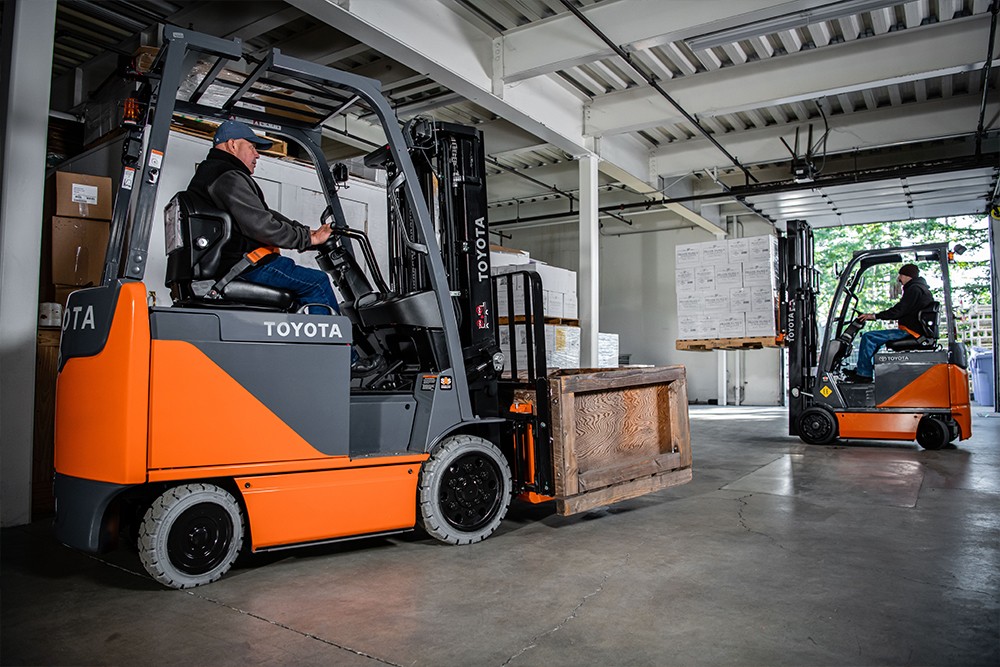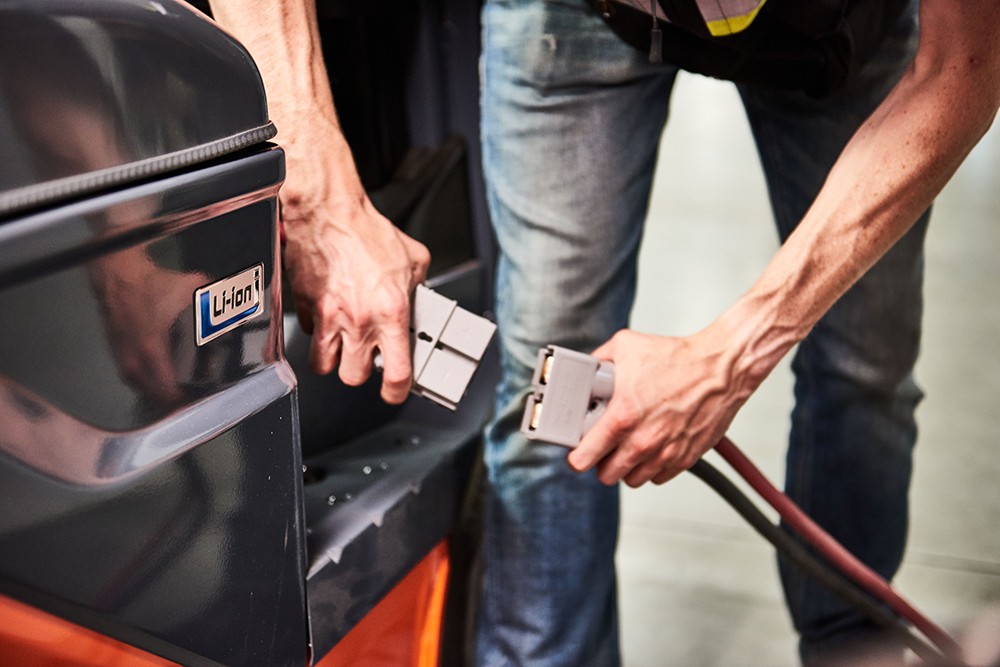Some trends in the material handling industry seem to come and go, but one "newish" trend that has stood the test of time is using electricity to power forklifts and other material handling equipment. Although engineers started tinkering around with building an electrically-powered piece of equipment that could be described as a forklift in 1923, it was decades before electrical forklifts and other material handling equipment became truly standard in the industry. Interestingly enough, according to the Material Handling Equipment Distributors Association, electric forklifts comprise the majority of new forklifts bought in the last 10 years. How's that for an upward trend?
Why have electric forklifts become so prevalent and desirable? After all, we've been powering the material handling industry just fine with gas, diesel and LPG, right? And while it's true that these classics have been chugging along with us as we've seen an explosion in material handling and distribution center economics, the world has been undergoing a shift during that time which begs for a cleaner, more efficient, and economical way to do business.
Enter electric, considered by many to be the gold standard for eliminating the toxic and dangerous by-products of burning fossil fuels - by-products that negatively impact air quality and lead to global warming. According to some reports, these emissions may cause cancer and aggravate respiratory illnesses, such as asthma. And while electric forklifts may not solve all the world's problems, choosing to take your business in a greener direction is certainly a good start. You might be surprised to learn that electric forklifts and other material handling and distribution center equipment can also save you money and increase your productivity in a number of ways. Let's explore some of those ways now.
The True Cost
The price you pay at the dealership for a new - or used - piece of material handling equipment is a line item on your annual financials. In some cases, you have budgeted for upgrading or adding to your fleet. In other cases, you may need to move some money around to cover an unexpected cost when something happens, like a surprising uptick in business - or worse, an equipment failure.
But that's just the beginning of figuring out the total - or true - cost of material handling equipment. You should have an amalgamated number somewhere in your financials that includes any number of varying items, including lifetime maintenance, lifetime power sources, increase (or decrease) in productivity and efficiency, tax incentives and more.
So, moving on from the check you wrote to the dealer for the equipment itself, maintenance is generally the next largest cost item associated with material handling equipment. With any fleet of material handling and distribution center equipment, maintenance is an ongoing issue. Whether you have one forklift or 200 forklifts, making sure your equipment is maintained is fundamental to your bottom line, as well as your overall productivity. Plus, as is true with almost everything you own, reliable and regular maintenance is non-negotiable if you want to get maximum benefits.
With forklifts and other material handling equipment, the smartest way to do business is by planning maintenance. Using regularly scheduled preventative maintenance to keep your equipment in tip-top shape sure beats the dreaded downtime that happens if something breaks or stops running and you are forced to call for service or parts.
Did you know that electrically-powered units, such as forklifts, have roughly a 40-50 percent reduction in maintenance costs when compared to their traditionally-powered brethren? According to Consumer Reports, electrically-powered vehicles cost more upfront, but significantly less over the life of the vehicle in total ownership costs. The reason is simple: fewer moving parts equals less maintenance and repairs, which in turn equals long-term savings to your bottom line. Now, this information refers to car ownership, but the savings in maintenance costs translates to all electrically-powered apparatus.
Because the electrically-powered forklift requires little to no maintenance (yes, you read that right), you'll save money over the course of your ownership. And now, with lithium ion (Li-ion) batteries available, the main power source for electrical equipment is better than ever. Li-ion batteries:
- can be recharged and used over and over again
- charge faster than traditional lithium or hydrogen cell batteries
- have a higher power density
- come in a lighter weight
Electrically-powered forklifts have no timing belts, don't need oil and other fluid changes and aren't powered by friction. There is no traditional radiator, but rather an air or liquid cooling system. There's typically no transmission and no clutch. With far less engine and other components to drive electric forklifts, there's far less that can go wrong. Overall, you aren't only looking at a lower bill for maintenance and service, you are also looking at less downtime - which is a huge boost to the bottom line.
Charge 'Er Up
Remember when we used to pull up to the gas pump and say "Fill 'er up!" That was a long time ago and things have really changed since then. Along with all the other changes, the world is having to decide how to move forward in a more conservative way in regards to using our resources. For now, there are several ways we can do that and the one that is most germane to the material handling and distribution center world is moving towards electrically-powered forklifts and other equipment.
There is more than one type of battery to choose from when deciding to go electric. Learning the differences and how they impact your particular application is something your material handling equipment dealer can help you with, but one thing they all have in common is their impact on your operation. There are several ways choosing electric will help you financially, and not the least among those are the numerous ways electrically-powered forklifts will boost your productivity and efficiency. Here are just a few:
- For those operations that run continuous shifts, your employees won't need to shut the show down to charge the battery. You'll be able to take advantage of "opportunity charging" during restroom or lunch breaks to "top off" the equipment battery and keep right on moving. For those smaller operations that run one shift, the ability is there to charge during the off-time.
- Electrical battery charging produces no smelly fumes or gasses, so charging can take place anytime, anywhere.
- Employees will be exposed to less - or no - toxic fumes associated with burning gasoline, which releases several harmful chemicals into the air. Time off - or worse, workers comp claims - will be less, resulting in a positive move in insurance rates.
- Electrically-powered forklifts and other material handling equipment is not noisy, therefore your employees and anybody else in the vicinity won't be exposed to potentially harmful noise levels.
As you can see, deciding to take the leap from traditionally-powered engines to electric forklifts and other material handling and distribution center equipment takes some serious thought. The upfront cost is going to be more than you are used to paying for this type of equipment, but in the long run you will see reduced costs in a variety of places that typically will add up to more money saved than the extra dollars you paid upfront.
Don't forget that there are federal and state incentives for switching to electric - so you might get even more of a break in upfront costs. At Madland Toyota-Lift, we've been around long enough to understand what it means to consider switching your fleet to electric. We've helped countless companies save money and time by planning and executing the best ways to purchase electric. And as a trusted Toyota dealer, we've got the Toyota Make the Switch Sales Event going on from now until the end of the year. It's a great time to take advantage of a special sales event, whether you run one forklift or many.
Contact us today at one of our three convenient locations to speak to a knowledgeable team member about making the switch!

